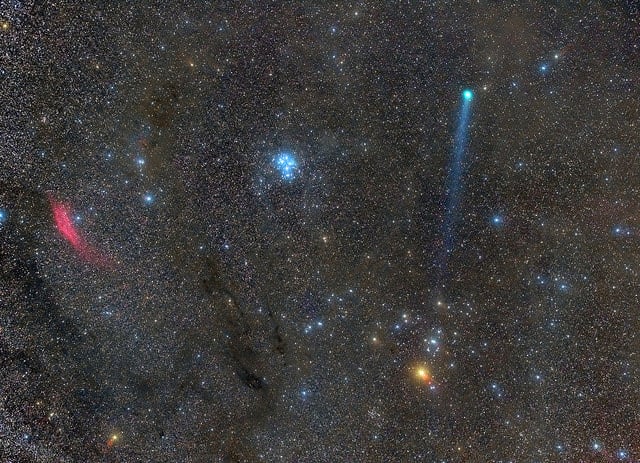Last night was the first time I was able to spot Comet Lovejoy with unaided eyes. The latest images from our readers and dedicated astrophotographers confirm that now is a good time to see the comet, which is reaching maximum brightness at his week.
Spaceweather.com
reports that many experienced observers say the comet is now shining at magnitude +3.8. With clear, dark skies C/2104 Q2 is easily seen with binoculars.
Enjoy this gallery of recent images, and if you've taken an image, consider joining
our Flickr pool
and submitting it. We may use your image in an upcoming article!
[caption id="attachment_118272" align="aligncenter" width="580"]
Comet Lovejoy C/2104 Q2 cruising past the open star Cluster M45 "Pleiades" or "The Seven Sisters." Credit and copyright: John Chumack. [/caption]
[caption id="attachment_118273" align="aligncenter" width="580"]
Comet Lovejoy taken on January 15, 2015 from Singapore. Credit and copyright: Justin Ng. [/caption]
[caption id="attachment_118274" align="aligncenter" width="580"]
Comet C/2014 Q2 Lovejoy in a widefield false color image taken on January 16, 2015 from New Mexico Skies. Credit and copyright Joseph Brimacombe. [/caption]
[caption id="attachment_118275" align="aligncenter" width="580"]
Comet Lovejoy, C/2014 Q2, a wide binocular field west of M45, the Pleiades star cluster in Taurus, on January 15, 2015, shot from Silver City, New Mexico. The long blue ion tail stretched back for about 8°. Credit and copyright: Alan Dyer. [/caption]
[caption id="attachment_118277" align="aligncenter" width="580"]
Comet Lovejoy photographed from Torrance Barrens Dark-Sky Preserve (30 km from Gravenhurst, Ontario, Canada; 200 km north of Toronto) on January 13, 2015. Credit and copyright: Michael Watson.
[/caption]
[caption id="attachment_118278" align="aligncenter" width="580"]
Comet Lovejoy as seen from Lahore, Pakistan on January 15, 2014, 10:30 pm local time. 35 single images stacked in DSS. Each 8 seconds, ISO 2000, f/5.6, edited in Photoshop. Credit and copyright: Roshaan Bukhari[/caption]
[caption id="attachment_118279" align="aligncenter" width="580"]
High resolution 3 panel mosaic of C/2014 Q2 on January 11, 2015. Field of view is approximately 3.5° x 2° and composed of three fields. Many fine streamers are visible emanating from the nucleus. Credit and copyright: SEN/ Damian Peach. [/caption]
[caption id="attachment_118281" align="aligncenter" width="580"]
Comet LoveJoy photographed from Kosovo on January 13, 2015. Credit and copyright: Suhel A. Ahmeti.[/caption]
[caption id="attachment_118283" align="aligncenter" width="580"]
C2014 Q2 Lovejoy on January 13, 2015. Credit and copyright: Shahrin Ahmad.
[/caption]
[caption id="attachment_118151" align="aligncenter" width="450"]
Comet Lovejoy on January 11, 2015. Credit and copyright: Henry Weiland. [/caption]
[caption id="attachment_118287" align="aligncenter" width="580"]
Wide angle shot of Comet Lovejoy with the constellation Orion, showing rich fields of red nebula, star clouds and dark nebula with the bright green naked eye comet. Credit and copyright: Chris Schur. [/caption]
[caption id="attachment_118152" align="aligncenter" width="580"]
Comet Lovejoy traveling through Taurus. Imaged on January 12, 2015 from Bathurst, New South Wales. Credit and copyright: Wes Schulstad. [/caption]
[caption id="attachment_118158" align="aligncenter" width="580"]
C2014 Q2 Lovejoy on January 7, 2015, taken from Bannister Green, England. Credit and copyright: Wendy Clark. [/caption]
 Universe Today
Universe Today

